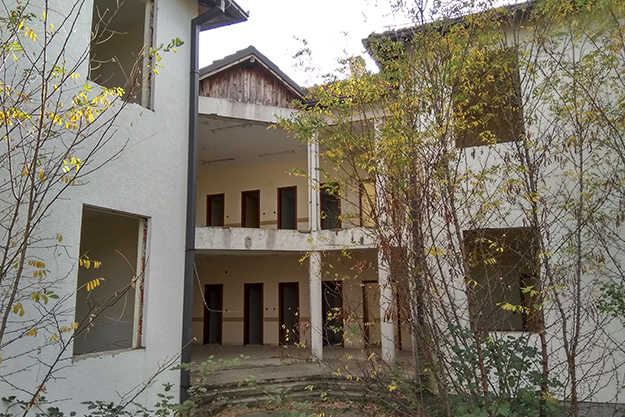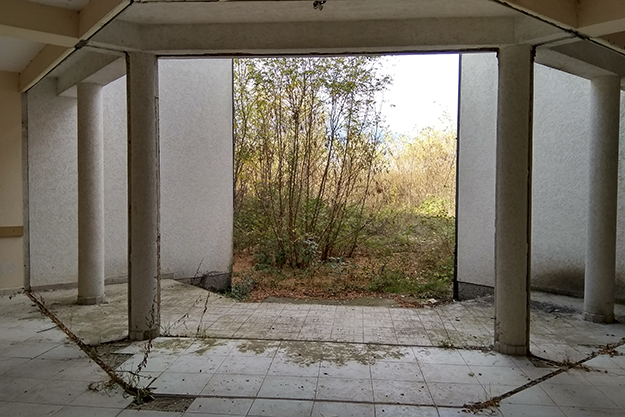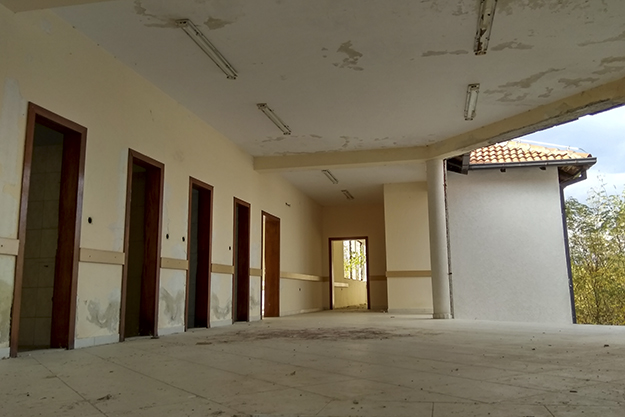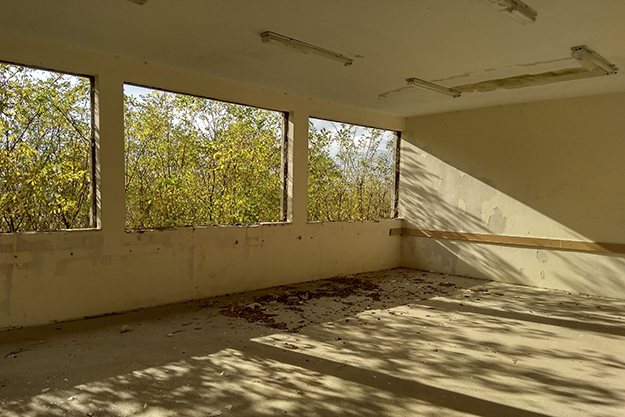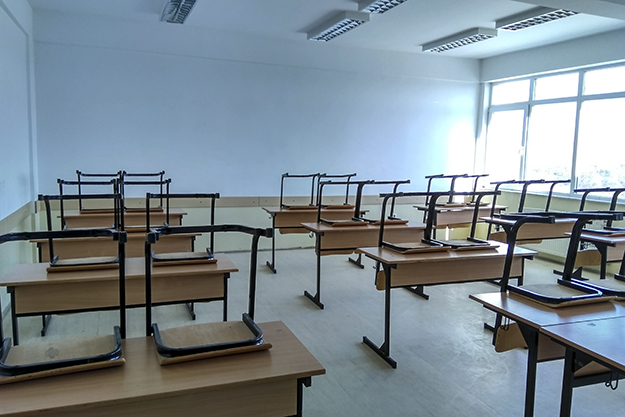Beside a road that connects a few villages near to Gjakova’s airfield, you can barely see a large building that looks modern but is partially covered by vegetation. The alley to reach the white two-storey building is completely overgrown, and getting along it now requires a bit of skill to avoid scratches from the head-high weeds that have engulfed it.
Built a matter of meters back from the main road connecting the villages of Janosh and Sopot with Novosella e Poshtme and Trakaniq, the building gives the impression of a relatively small but fresh school, with spacy rooms and big windows. Indeed, that is the purpose for which it had been intended when it was built in 2004.
On a Wednesday afternoon in October, pupils walk by on the concrete road with bags on their shoulders, most of them unaware that just a few years ago a school was built for them near their villages — they’ve never held classes there. The facility has been completely abandoned for a decade and a half, and today lies partially destroyed.
Some of the children who live in Janosh say that they are used to walking with heavy bags every day for two kilometers to go to Engjëll Gjoni school in Novosella e Poshtme, where children from Sopot and Trakaniq — both three kilometers away — also hold classes.
The school in Novosella e Poshtme is old. Staff say that it was built in 1983 and now has less than 200 pupils, a sign of changing demographics and rural flight in the past two decades. They and other residents from older generations in Novosella are aware that there is a school in Janosh but do not know why pupils never took classes there.
Even the Municipality of Gjakova and the Ministry of Education, Science and Technology (MEST) are unable to provide concrete details on what happened with the Janosh school.
Back in October 2018, K2.0 sent a series of official requests for accessing public documents in relation to the planning and construction of the facility, which the Law on Access to Public Documents requires public institutions to respond to within seven days. MEST failed to respond to the information request at all.
Meanwhile, Kastriot Shehdadi, an information officer who deals with access to public documents at the Municipality of Gjakova, said that the Municipality does not possess any documents for the construction of the school in Janosh, citing a 2015 Ministry of Public Administration regulation that determines the required time limit for keeping public documents; seven years for procurement documents, and 10 years for tender dossiers, administrative acts and contracts.
Without proper documentation, accountability for such an expensive white elephant is hard to come by, particularly since many of the public officials from that time have since retired.
Current head of the Municipal Assembly in Gjakova, Anton Berisha — who was also director of education in Gjakova between 2008 and 2010 — says the school was built by MEST, but Gjakova’s current director of education, Bernard Frrokaj, says he recalls it being built with a combination of Municipality funding and foreign aid.
Both current officials however point to declining numbers in rural areas for the facility remaining unused, saying that the number of pupils in this area fell “dramatically” in the post-war period.
“I don’t know upon what parameters they based the decision to construct this school.”
Bernard Frrokaj, Gjakova's director of education
Fadile Dyla, director of MEST’s Infrastructure Department, says that such a phenomenon of declining numbers has been witnessed in rural areas throughout Kosovo and has caused a big challenge in the post-war reconstruction process.
“After the war, the condition of the education facilities was not good because of the destruction and burning,” he says, referring to the fact that many education facilities were destroyed by Serbian forces. “Funds from abroad entered the country with the intention of reversing this situation and the idea was to build schools that would serve children that lived in these localities before the war. But, after the war, residents often did not go back to their old localities, thereby creating an overpopulation situation in the urban areas.”
The demographic shifts, and lack of adequate planning to accommodate them, means that while rural schools such as the one in Janosh lie empty, many schools in Kosovo’s cities operate in three shifts and with shortened lesson times, simply to accommodate the large number of pupils. “In almost every city we have this problem of overcrowded schools,” Dyla says.
Frrokaj says that in light of the demographic shifts in the area around Janosh, there was no need to build a new school there at all.
“Surely at the time they didn’t conduct a feasibility study to see whether or not there was a need for a new school,” he says. “Had such a study been conducted, the school wouldn’t have been built. I don’t know upon what parameters they based the decision to construct this school.”
Poor planning
Such lack of adequate infrastructure planning is evident throughout Kosovo.
In recent years, the construction of new schools in Kosovo has been marked by suspicions of irregularities and a lack of effective planning, with experts stating that cases such as the abandoned school in Janosh are not isolated anomalies.
According to Kosovo’s current Education Strategy, in the period 2017-2021 MEST, foresees spending approximately 50 million euros on the construction of 25 new school primary and secondary schools, and 18 new preschools — which it says is enough new schools to enable one-third of all pupils to conduct classes in a single shift.
The strategy says that “identification of locations for the construction of new schools will be based on the analysis of the school map (investment plan), according to the applicable norms and standards and the expected demographic changes.” But a MEST spokesperson said that this document was still being finalized, in collaboration with the World Bank, and that it is not currently available.
With the number of intended new schools already set apparently before the identification of required locations has been completed, it is unclear to what extent these plans take account of significant demographic shifts.
At a recent roundtable discussion organized by opposition party Vetëvendosje, Kosovo Education Center’s Dukagjin Pupovci stated that the number of pupils engaged in pre-university education in Kosovo has decreased by 90,000 in the past decade. According to data from Kosovo Agency of Statistics and MEST, 284,044 pupils attended 954 primary schools in 2018, while 91,345 pupils attended 122 secondary schools.
Halim Hyseni, an expert with many years of experience in education, formerly as a professor and member of the Steering Council at the University of Prishtina and now a board member of Kosovo Education Center, says that the process of constructing school facilities has been characterized by many irregularities since the end of the war.
“Corruption has devoured physical education halls, classrooms and other supplementary facilities.”
Halim Hyseni, education expert
The construction and planning of new education buildings has always been an important part of electoral campaigns and promises from politicians, especially for rural localities where schools and other administrative buildings form an integral part of government investments.
The most recent general election campaign saw the trend continue, with PDK and AAK — two parties that would go on to form the basis of the government coalition — promising significant investment in education infrastructure if elected. AAK officials often mentioned that Kosovo’s infrastructure lacked the necessary space, while PDK officials repeatedly mentioned that investment in schools would pass to a “new phase,” although failed to elaborate what this meant in practise.
Hyseni says that over the years, the public perception has been that politicians have used the education system and schools for political purposes during the election processes, while after elections investments have often been directed in those areas containing strong electoral support for the elected parties, thereby forming a direct link between votes and public investments.
He assesses that there have been many past instances of abuse and misuse of power when it comes to constructing new facilities, connected to the various political interests of those making decisions in the education sector.
“Corruption has left the constructed facilities with many deficiencies, far from 21st century standards,” Hyseni says. “This has happened in Ferizaj, Istog, Drenas and many other municipalities. Corruption has devoured physical education halls, classrooms and other supplementary facilities.”
‘I don’t need bricks if I don’t have pupils’
Even when the quality of new educational structures is not in doubt, lack of foresight in the planning process can still lead to new facilities that don’t meet the requirements for the right educational development of pupils.
Five years ago, Gjilan’s Agribusiness High School opened a new campus in the city’s Arbëria neighborhood. Located on a 35 hectare site, three kilometers from the city center, the Arbëria School is estimated to be one of the best facilities in the region for professional training in agriculture and has its own agrochemical laboratory.
However, in February 2017, less than three years after the school had fully opened its doors, Gjilan’s director of education took the decision to move theory lessons to the Mehmet Isai Technical High School campus in the center of Gjilan; now, pupils only hold practical lessons at the Arbëria site.
At the time, officials in Gjilan’s Education Directorate stated that the move would be a temporary one, but there appears to be no change in sight, and there are local rumors that another purpose is now being sought for the building.
The director of the agriculture school, Xhelal Jetishi, says that a lack of security at the new site contributed to a drastic reduction in the number of pupils, forcing them to move classes elsewhere in the city. “Five hundred to 600 students were moved to the new facility, but then [by 2017] only 170 remained — in the last year, we had only 40 high school graduates,” Jetishi says, adding that a year after theory classes moved back to the city center, the number of students grew to 249.
“At the location of the new school, there is no cafeteria or shop to serve students, and during break pupils were forced to stay inside the facility and this influenced their social education.”
Xhelal Jetishi, school director
The influx of the agribusiness pupils meant that classes at the Technical High School had to be reduced from 40 to 35 minutes, however the Education Directorate at the Municipality of Gjilan justified the decision by citing a lack of security at the Arbëria campus, as well as the fact that pupils didn’t like holding classes outside of the city.
Jetishi illustrates the lack of security in Arbëria with an incident that happened in early February 2017, when a pupil and his parent attacked teachers of the school with an axe. The incident, which was confirmed by the police at the time, came after an altercation between the pupil and teachers that turned physical. Minutes later, the pupil returned to the school with an axe, accompanied by his father. The two of them attacked two teachers who were the nominated caretakers for the day, causing injuries.
“On the [city center] campus in which we have been located for the past 18 months, no incidents have occurred,” Jetishi says. “At the location of the new school, there is no cafeteria or shop to serve students, and during break pupils were forced to stay inside the facility and this influenced their social education.”
The distance from the city center, and a lack of transportation to the new site also proved problematic, with no urban transport in Gjilan.
Back in 2009, at a ceremony to open the first reconstructed building on the Arbëria site, the then director of education in Gjilan, Ismajl Kurteshi, stated that the Municipality would provide transportation for pupils from the city to the agriculture school. Initially, the Municipality paid for the transportation of pupils from the city to the school by bus, but it was quickly discontinued; education officials in the city suggested that this was due to a combination of high costs of tens of thousands of euros per year, and falling pupil numbers.
Jetishi is frustrated at the choice of location for the agriculture school, saying that the facility could have been built within the high school campus in the city center, which is home to all of Gjilan’s high schools. “I don’t need bricks if I don’t have pupils,” he says.
As with the abandoned school in Janosh, tracing back the history of the decision to build the new Arbëria campus outside of Gjilan city center is not straightforward, despite its relatively recent construction.
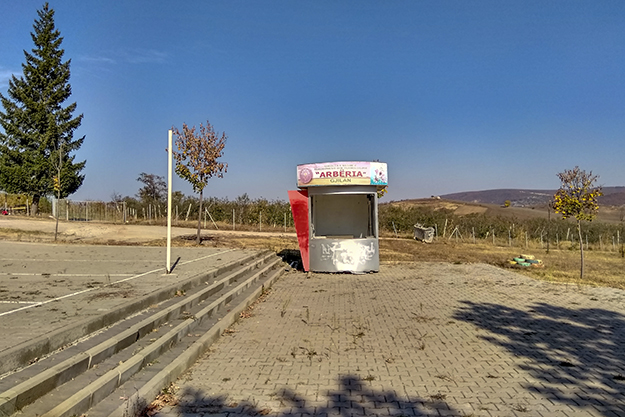 Photo: Arian Lumezi / K2.0.
Photo: Arian Lumezi / K2.0.
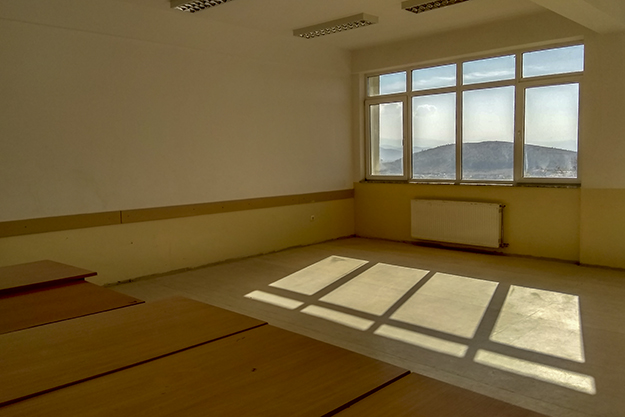 Photo: Arian Lumezi / K2.0.
Photo: Arian Lumezi / K2.0.
 Photo: Arian Lumezi / K2.0.
Photo: Arian Lumezi / K2.0.
Using the Law on Access to Public Documents, K2.0 sent multiple requests for documents to the Municipality of Gjilan’s Education Directorate — and twice met with officials within the Directorate — but received none of the requested information relating to the campus construction. The Municipality’s director of education, Nazim Gagica, refused to comment on the issue, saying that the Directorate would not provide any further information other than what the school’s director had already provided.
What is known, is that the site on which the school campus is located was previously utilized by the Kosovo Protection Corps (KPC), which initiated the construction of the buildings that have subsequently been converted for educational purposes. When the KPC transformed into the Kosovo Security Force (KSF), in 2009, the building was still unfinished, and KSF decided that it no longer needed the facilities.
In 2009, Danish International Development Agency (Danida) provided funding for a 30,000 euro laboratory on the site that enabled pupils from the Agribusiness High School to conduct some of their practical work there.
Later that year, the Municipality of Gjilan, together with MEST, sought further financial support from Danida, to complete facilities that could be used to serve students who had decided to attend pre-graduate professional training.
Lotte Mindedal from the External Ministry of Denmark says that Danida contributed around 670,000 euros to this project, which was titled “Support For the Development of Agriculture in the Municipality of Gjilan.”
“After KSF left it unfinished, the Municipality of Gjilan sought aid to finish the construction with the objective of transforming it into an agriculture school,” Mindedal says. “This was in accordance with the interests of the Ministry of Education and Ministry of Agriculture in Kosovo.”
Mindedal says that the initially stated time period was 18 months, up to December 2011, however the implementation of the project was delayed for two years, until December 2013; once construction was completed, she says the building was handed over to the Municipality in April 2014.
The Danish investment covered the construction and installment of the water supply network as well as the furnishing; the completed school has a main facility with equipped classrooms, as well as a supplementary smaller building containing the lab.
But while building brand new school facilities such as the Arbëria School on the edge of Gjilan continues to be a focal point of government investments in education in Kosovo, it’s unclear if any lessons have been learned from the mistakes of the past.K
Feature image: Arian Lumezi / K2.0.
This article has been produced with the assistance of the European Union. The contents of this publication are the sole responsibility of Kosovo 2.0 and can in no way be taken to reflect the views of the European Union or BIRN and AJK.

